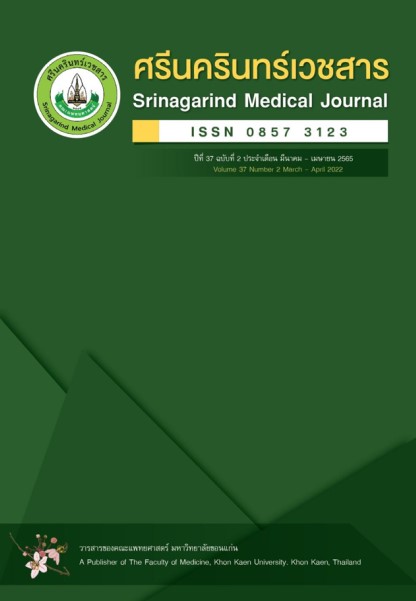Botulinum Toxin Treatment in Parotid Sialocele and Parotid Sialocutaneous Fistula
Keywords:
Botulinum toxin, Sialocele, Sialocutaneous fistula, Parotid glandAbstract
Background and objective: Although parotid sialocele and parotid sialocutaneous fistula are rare in occurrence, they greatly affect patients' quality of life. The main cause of these conditions is the complication after parotidectomy. In recent years, one of the noninvasive treatments that have been gaining increasing recognition is botulinum toxin (BT) injection in remaining parotid tissue but there is still a lack of data due to the limited number of patients. This study aimed to assess the clinical characteristics of patients, BT injection technique, and effectiveness of BT in the management of these conditions.
Method: A retrospective descriptive review of patients who had been treated with BT for parotid sialocele and/or parotid sialocutaneous fistula at Department of Otorhinolaryngology, Srinagarind hospital from 1st January 2011 to 30th June 2021.
Result: Six patients developed parotid sialocele and/or parotid sialocutaneous fistula after parotid gland surgery and one developed both of these conditions after having a penetrating injury on the face involving the parotid area. All patients were treated by injection of BT into the remaining parotid tissue with a post-injection pressure dressing. The mean dosage of BT was 30 units (20-50 units). Complete healing was achieved after the single injection of BT in all patients. Patients with parotid sialocele did not experience further swelling after the first BT injection. The mean duration of fistula healing after BT injection was 14 days (5-30 days). No side effects and recurrence were observed after treatment.
Conclusion: BT injection with a pressure dressing in the patient with parotid sialocele and parotid sialocutaneous fistula is not difficult, safe and highly effective. We recommend an early injection of BT within 6 weeks after the development of these conditions.
References
Lee YC, Park GC, Lee J-W, Eun YG, Kim SW. Prevalence and risk factors of sialocele formation after partial superficial parotidectomy: A multi-institutional analysis of 357 consecutive patients. Head Neck 2016;38(Suppl 1):E941-944.
Costan V-V, Dabija MG, Ciofu ML, Sulea D, Popescu E, Boisteanu O. A Functional Approach to Posttraumatic Salivary Fistula Treatment: The Use of Botulinum Toxin. J Craniofac Surg 2019;30(3):871–5.
Laskawi R, Winterhoff J, Köhler S, Kottwitz L, Matthias C. Botulinum toxin treatment of salivary fistulas following parotidectomy: follow-up results. Oral Maxillofac Surg 2013;17(4):281–5.
Maharaj S, Mungul S, Laher A. Botulinum toxin A is an effective therapeutic tool for the management of parotid sialocele and fistula: A systematic review. Laryngoscope Investig Otolaryngol 2020;5(1):37–45.
Schindel J, Markowicz H, Levie B. Combined surgical-radiological treatment of parotid gland fistulae. J Laryngol Otol 1968;82(10):867–70.
Demetriades D, Rabinowitz B. Management of parotid sialoceles: a simple surgical technique. Br J Surg 1987;74(4):309.
Isaacson J, Patel S, Torres-Yaghi Y, Pagán F. Sialorrhea in Parkinson’s Disease. Toxins 2020;12(11):E691.
Ellies M, Laskawi R, Rohrbach-Volland S, Arglebe C. Up-to-date report of botulinum toxin therapy in patients with drooling caused by different etiologies. J Oral Maxillofac Surg Off J Am Assoc Oral Maxillofac Surg 2003;61(4):454–7.
Chow TL, Kwok SPY. Use of botulinum toxin type A in a case of persistent parotid sialocele. Hong Kong Med J Xianggang Yi Xue Za Zhi 2003;9(4):293–4.
Donoso T, Domancic S, Argandoña J. Delayed treatment of parotid sialocele: a functional approach and review. J Oral Maxillofac Surg 2015;73(2):284–90.
Cavanaugh K, Park A. Postparotidectomy fistula: a different treatment for an old problem. Int J Pediatr Otorhinolaryngol 1999;47(3):265–8.
Dressler D, Adib Saberi F. Botulinum toxin: mechanisms of action. Eur Neurol 2005;53(1):3–9.
Vargas H, Galati LT, Parnes SM. A pilot study evaluating the treatment of postparotidectomy sialoceles with botulinum toxin type A. Arch Otolaryngol Head Neck Surg 2000;126(3):421–4.
Send T, Bertlich M, Eichhorn KW, Bootz F, Jakob M. Management and Follow-up Results of Salivary Fistulas Treated With Botulinum Toxin. The Laryngoscope 2019;129(2):403–8.
Marchese Ragona R, Blotta P, Pastore A, Tugnoli V, Eleopra R, De Grandis D. Management of parotid sialocele with botulinum toxin. The Laryngoscope 1999;109(8):1344–6.
Downloads
Published
How to Cite
Issue
Section
License
Copyright (c) 2022 Srinagarind Medical Journal

This work is licensed under a Creative Commons Attribution-NonCommercial-NoDerivatives 4.0 International License.




